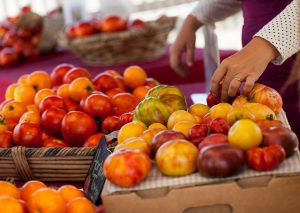Ten California programs receive funding to increase the availability of local foods in schools
This week the U.S. Department of Agriculture announced projects selected to receive the USDA’s annual farm to school grants designed to increase the amount of local foods served in schools. Sixty-five projects were chosen nationwide.

Photo Courtesy: USDA Food and Nutrition Service A summer feeding program in Sacramento, California, features a farmers market with heirloom tomatoes.
USDA Farm to School grants can help farm to school programs get started or expand existing efforts. Funds support a wide range of activities from training, planning, and developing partnerships to creating new menu items, establishing supply chains, offering taste tests to children, purchasing equipment, planting school gardens, and organizing field trips to agricultural operations.
Grantees include schools and districts (large and small, rural and urban), Indian tribal organizations, agricultural producers or groups of agricultural producers, non-profit entities, and state and local agencies.
Programs awarded in California include:
CDFA’s Office of Farm to Fork:
CDFA’s Office of Farm to Fork will transition the California Farm to School Network (CFSN) to the Office and strengthen the already robust statewide organization with a five-pronged approach, which will result in an increase in fresh California foods offered at school meals across the state and an increase in sales for California farmers.
Tides Center/School Food Focus, a Project of Tides Center (San Francisco):
School Food Focus will increase school food demand for locally-sourced poultry products. Working in the Southeastern and the Western regions of the U.S., Focus will bring together four innovative school food service leaders and a range of small and mid-scale poultry producers, processors, and distributors to create mutually beneficial procurement pathways to better chicken and turkey products.
Karuk Tribe (Happy Camp)
This project will enhance students’ understanding of the connections between and the direct experience with traditional foods, physical health, and diet-related disease prevention. Karuk Tribe, with their partners, will expand and implement culturally relevant “Native Health” lesson plans and facilitate conventional and Native food cooking classes for a “hands-on” approach to their local food systems.
Fresno County Economic Opportunities Commission
The FRESH initiative will develop a policy, which recommends a set percentage of Fresno Unified School District’s (FUSD) food budget for local produce and will increase connections between local growers and FUSD. This will be achieved by convening farm to school Meet-and-Greet events that will introduce local farmers to FUSD Food Services. The FRESH initiative will educate students about the role of fruits and vegetables through six experiential nutrition education and taste testing events to 250 students.
Food Bank of Santa Barbara County
The Food Bank of Santa Barbara County will provide fresh produce and nutrition education lessons to elementary-aged students in afterschool programs. Each lesson focuses on one special produce item and includes recipes, information about the ingredient, and a hands-on food demonstration in which children prepare and taste the recipe of the day. The lesson concludes with a mini farmer’s market that includes the main ingredient as well as three other fresh produce items.
Other California Farm to School grants include: Twin Rivers Unified School District (North Highlands); Oakland Unified School District; New Vision Middle School (San Bernardino); Natomas Unified School District (Sacramento); and Local Bounty (Moss Landing).
USDA News Release on the program and complete List of Awardees.


